Top Image: The officers of the War Plans Division worked diligently to support the initiatives of Army Chief of Staff George C. Marshall throughout the ARCADIA Conference. Pictured are Brigadier General R.C. Crawford, Brigadier General Dwight D. Eisenhower, and Brigadier General Leonard Gerow War of the War Plans Division, War Department General Staff in January, 1942. US Army image courtesy of the Library of Congress.
In the immediate aftermath of the Japanese attacks on Pearl Harbor and the Philippines and the German declaration of war on the United States, the American strategic direction for waging the war was in question. Earlier in 1941, the United States and the United Kingdom had agreed upon a strategic approach of “Germany First” in the event of a two-front war against Nazi Germany in Europe and Imperial Japan in the Pacific. British Prime Minister Winston Churchill was deeply concerned that the character of the Japanese attacks, and recent Japanese successes in the Far East, would divert the two countries from their planned approach or shift the allocation of American war materiel that Britain had been receiving.
In late December 1941 Churchill came to Washington, DC for a summit conference with President Franklin D. Roosevelt and his senior military leaders. It became known as the First Washington Conference, code-named ARCADIA, and ran from December 22, 1941 until January 14, 1942.
In Churchill’s thinking, the purpose of the Washington Conference was to “review the whole war plan in light of reality and new facts, as well as the problems of production and distribution.” Churchill believed that with the United States as an active co-belligerent in World War II, an Allied victory was possible. Victory, however, was not a foregone conclusion.
Churchill appreciated that throughout history coalitions have had a difficult time waging war, and the unique or competing interests of coalition members often undermined their efforts.
Accompanying Churchill were representatives of the British Chiefs of Staff and officers tasked with manning a liaison mission in Washington, DC. The British military delegation included Admiral of the Fleet, Sir Dudley Pound, First Sea Lord and Chief of the Naval Staff, and Air Chief Marshal Sir Charles Portal, Chief of the Air Staff. The British Army was represented at the ARCADIA Conference by Field Marshal Sir John Dill, the recent Chief of the Imperial General Staff; his successor General Sir Alan F. Brooke remained in London as caretaker of the Chiefs of Staff Committee. Dill was selected to remain in Washington after the conference. The British Chiefs of Staff Committee also included Churchill’s personal representative, Lieutenant General Sir Hastings L. Ismay, Chief of Staff to the Minister of Defence, a portfolio that Churchill held.
As the British delegation was at sea heading to the United States, then-Brigadier General Dwight D. Eisenhower, the deputy in the War Plans Division of the War Department General Staff, assessed the importance of the ARCADIA Conference. Eisenhower recognized that there was a need to recommend a scheme for waging “the war against Germany and Japan, enemies which were widely separated geographically” and “each in possession of a rich empire.” He also concluded that a defensive war would not achieve America’s goals. He asserted, “We had to attack to win.”
Eisenhower assessed that the ARCADIA Conference had two principal purposes. Consistent with the emphasis Army Chief of Staff General George C. Marshall placed on achieving unity of effort, Eisenhower recognized that the first was organizing “a workable system by which the American and British Chiefs of Staff could operate effectively as a team.” Related to this was the challenge of achieving national and coalition unity of effort among the forces in the various theaters of the global war.
The second purpose, Eisenhower noted, “was to confirm earlier agreements upon the region in which should be the object of our attacks.” Those earlier agreements had called for a strategic approach of “Germany First.” The conference also considered immediate military requirements and the appropriate allocation of resources within the Anglo-American Grand Alliance.
Mechanisms for Unity of Effort
Throughout the ARCADIA Conference, General Marshall emphasized coordinating mechanisms to ensure interallied and interservice cooperation. In Marshall’s mind, the military principle of unity of effort was essential for the political and military leaders of the two governments to achieve decisive results in the theaters of the war.
Evidently hoping to establish a precedent on December 25, Marshall proposed a bold allied command arrangement for establishing “unified command in each natural theater.” He advocated placing all the ground, naval, and air forces of the Allied powers under a single theater commander. As a concrete example, he directed Eisenhower to develop the instructions for such a command in the Southwest Pacific and Southeast Asia.
The British initially expressed their reluctance to support such a step. Churchill told his military leaders that he “was not at all convinced that this arrangement was either workable or desirable.” Marshall, however, persuasively highlighted the importance of a system for unified control that could overcome service prerogatives and national rivalries in order to plan effectively and operate decisively. Churchill noted that Marshall “pleaded [his] case with great conviction.”
Ultimately, Marshall’s proposal gained the acceptance of his naval counterpart, the British, and President Roosevelt. The result was the establishment of the ABDA (Australian-British-Dutch-American) Command and an important precedent for the Anglo-American war effort by placing all British and American ground, naval, and air forces in a theater under a single commander.
On January 10, General Sir Archibald P. Wavell, the Commander in Chief of British forces in India, was formally appointed as Supreme Commander, ABDA. Over the previous two weeks, Eisenhower, at Marshall’s direction, had been drafting and staffing the directive which included authorities and national prerogatives. It was a laborious process. Eisenhower noted on January 2, “Unity of command in ABDA area seems assured. Good start!—but what an effort. Talk-talk-talk.” Notably, Eisenhower’s final directive also included the formation of a combined staff for each of the theater commands.
The question of who those possible Allied theater commanders and their staffs would report to presented another organizational challenge at ARCADIA. To address that problem, the British proposed and Marshall quickly endorsed what historian and Marshall biographer Mark A. Stoler characterized as “another revolutionary and unprecedented structure, the Anglo-American Combined Chiefs of Staff (CCS), to plan combined global strategy and direct Anglo-American forces around the world.”
The planners agreed that the term “joint” would be used for interservice matters within a country’s armed forces and “combined” would be used for issues requiring collaboration between forces of two countries; those remain the doctrinal terms in the US Armed Forces 80 years later.
The CCS became the supreme Allied command, and the first formal meeting was held on February 9, 1942. The CCS was composed of the army, navy, and air chiefs of staff of the two countries, and leaders agreed that it would meet continuously in Washington, DC. Marshall insisted that the CCS report directly to Roosevelt and Churchill and that the body also control the prioritization and allocation of wartime production and the strategic deployment of forces.
To support the processes of the new supreme command organization, on January 10 the British proposed leaving permanent representatives in Washington, and their Joint Staff Mission in Washington represented the British Chiefs of Staff on a regular basis, except during those wartime conferences where the chiefs could participate in person. Dill was designated the first head of the British Joint Staff Mission and the representative of the Prime Minister. Churchill assessed that Dill’s “personality, discretion, and tact gained him almost at once the confidence of the President.”
During the war, the senior British officers in the Joint Staff Mission from each service represented their respective Chiefs. Churchill observed,
These representatives were in daily, indeed hourly, touch with London, and thus were able to state and explain the views of the British Chiefs of Staff to their United States colleagues on any and every war problem at any time of the day or night.
Implementation of the CCS organization also required a change in the US military structure to correspond with the British system. The British Chiefs of Staff Committee included the army, navy, and air chiefs as well as the personal representative of the Prime Minister. In the United States, the existing Joint Board was built around two principals: the Chief of Staff of the Army and the Chief of Naval Operations, with their air and planning subordinates in support.
Recognizing the need for change, Roosevelt created a body to serve the new role, replacing the old Joint Board and assuming its remaining planning and coordinating functions. Initially labeled the Joint United States Chiefs of Staff, the body was soon designated as the Joint Chiefs of Staff (JCS).
In his creation of the JCS and the changes to the Joint Board, Roosevelt benefited from Congress passing the First War Powers Act on December 18, 1941. That legislation conferred upon President Roosevelt the power to reorganize federal agencies in order to “expedite the prosecution of the war effort.” As his guiding policy for the JCS, Roosevelt stipulated that “matters which were purely military must be decided by the Joint Chiefs of Staff and himself, and that, when the military conflicted with civilian requirements, the decision would have to rest with him.”
Marshall brought his subordinate, Lieutenant General Henry H. Arnold, the Chief of the Army Air Forces and US Army Deputy Chief of Staff, into the JCS as an equal. Initially the JCS included the Chief of Naval Operations (CNO), Admiral Harold “Betty” Stark, as well as the commander of the US Fleet, Admiral Ernest J. King. When King assumed both duties in March 1942, Marshall proposed filling the vacant chair with retired Admiral William D. Leahy as a special representative of the president. Leahy, a former CNO, governor of Puerto Rico, and US Ambassador in Vichy, France, was brought out of retirement in July 1942 to serve as “chief of staff to the commander in chief.”
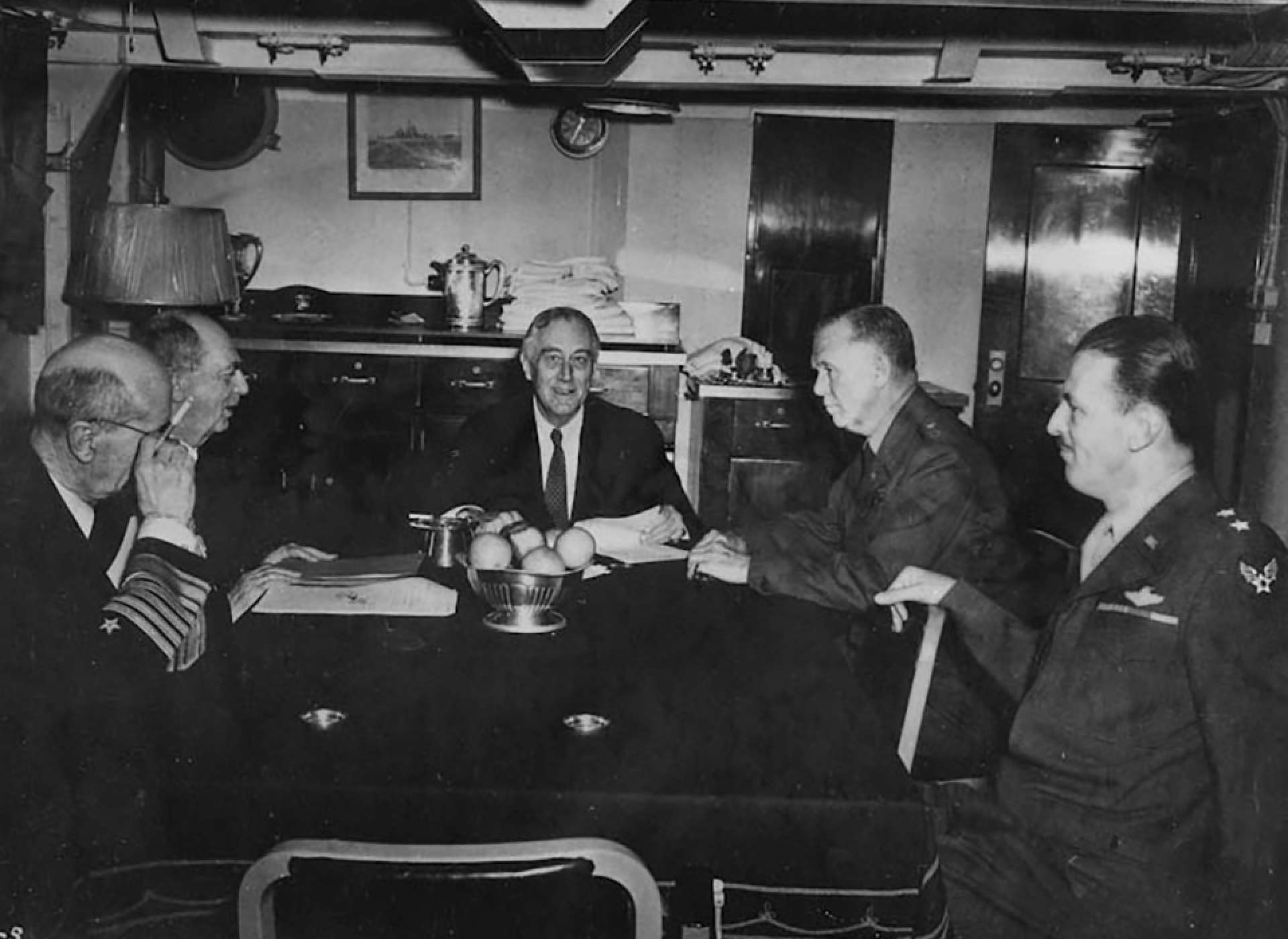
President Franklin D. Roosevelt meeting with his Joint Chiefs of Staff on board the USS Quincy later in the war. Left to right: Admiral Leahy, Admiral King, FDR, General Marshall, and Major General L.S. Kuter, General Arnold's representative. Image courtesy of the FDR Library.
Leahy served as the senior of the five-star admirals and generals, presided over the JCS, and provided their daily contact with President Roosevelt. In 1947, Leahy’s ad hoc wartime post would become formalized in legislation as the position of the Chairman of the Joint Chiefs of Staff. The JCS has remained the centerpiece of the US military establishment since its creation in 1942.
Concerning unity of effort in theaters of war, although the ABDA Command was short-lived, the precedent for unified command held. On March 7, Roosevelt proposed dividing the world into three general theaters or operational areas and designating lead responsibility. The British gave their approval on March 18. The three theaters were: the Pacific, an American strategic responsibility; the Middle and Far East, under British command; and the Atlantic and European theater, shared by the United States and the United Kingdom.
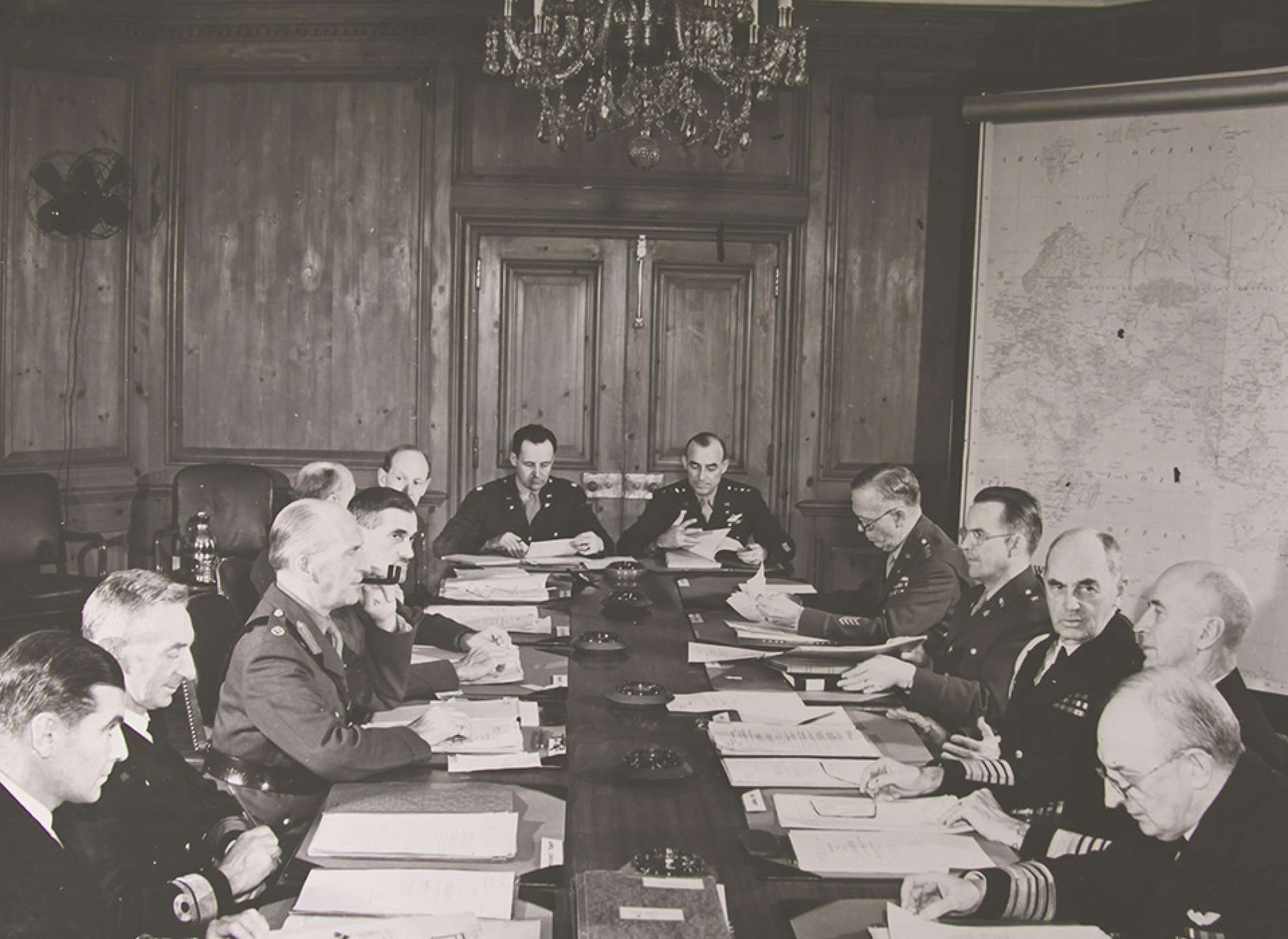
A meeting of the Combined Chiefs of Staff in the Public Health Building in Washington, DC circa 1943. Image courtesy of the Joint History and Research Office.
The CCS were responsible to oversee all three areas and exercised operational oversight in the shared Atlantic and European areas. In the Pacific, the United States opted to give the US Navy control of the north, central, and south Pacific under Admiral Chester W. Nimitz. Rather than attempt to relegate General Douglas MacArthur under Nimitz, particularly since MacArthur had greater seniority, the US Army was given the Southwest Pacific for his command.
American War Plans and Allied Strategic Direction
In the 1920s and 30s, American war plans, known as the Color Plans, typically envisioned the United States at war with a single country. Using a convention adopted initially in 1904, the United States was always BLUE, a designation that is still in use for US Forces today. Potential adversaries were designated by a color, for instance BLACK for Germany, GREEN for Mexico, and ORANGE for Japan.
Following the German invasion of Poland in 1939, however, US Army and Navy planners were ordered to consider the potential for the United States to be involved in a war with more than one major power, specifically a coalition of the Axis powers Nazi Germany, Imperial Japan, and Fascist Italy. The new family of plans for a two-front war were labeled the RAINBOW plans.
As the planners considered the strategic options on the onset of the Second World War in Europe, they developed five scenarios. The possibility that the United States would be fighting the Axis coalition by itself was the basis for RAINBOW 1, 3, and 4. RAINBOW 1 and 4 considered continental versus hemispheric defense, and RAINBOW 3 envisioned offensive operations in the Pacific against Japan. RAINBOW 2 and 5 rested on the assumption that Britain and France were allied with the United States.
The options presented in those two plans were either RAINBOW 2’s primary military effort against Japan or, in the case of RAINBOW 5, assuming a defensive posture in the Pacific against Japan while concentrating forces for expeditionary operations into Africa or Europe.
During 1940, as Germany achieved rapid successes in Western Europe, attention focused primarily on the plans for hemispheric defense. In late 1940, it became evident that the changed strategic environment required a reconsideration of the strategy.
CNO Admiral Stark took the lead, arguing that in the event of war the only sound strategy for the United States would be an updated RAINBOW 5. Stark laid out his conclusions in a memorandum for President Roosevelt. Stark’s memorandum, known as Plan DOG, recommended assuming a defensive posture in the Pacific against a relatively weaker Japan while concentrating forces with Britain in the Atlantic-European theater to defeat Germany, which was more powerful and posed a greater threat. Stark also recommended military staff conversations with the British on this approach.
President Roosevelt agreed with Stark’s conclusions, and the revised RAINBOW 5 became the basic war plan and the foundation for the Anglo-American staff talks in Washington in March 1941. The result of those American-British Conversations (ABC-1) was an agreement for a “Germany First” approach consistent with the framework in RAINBOW 5 in the event the United States entered the war.
Soon after the ARCADIA Conference began, it became clear to the British planners that, despite the dangerous situation in the Pacific and Far East, it remained the American view that the basis of the Allied strategic approach must have the defeat of Germany as its primary objective.
In line with their British counterparts, American planners asserted that the countries at war with Germany should increase their production of munitions and materiel and raise additional forces. Those forces would be used to defend their territories and retain strategic outposts, weaken the resistance of Germany, and prepare for the final assault. As Marshall observed to the JCS in early March, “We should never lose sight of the eventual necessity of fighting the Germans in Germany.” The Joint Chiefs urged the buildup of forces in the United Kingdom for the earliest feasible landing on the Continent of Europe while limiting additional deployments to the Pacific.
The sic approach, outlined by Churchill upon his arrival in Washington, was quickly embraced by Roosevelt and his military chieftains. The framework contained five key elements that would continue to guide the Allied strategy for the remainder of World War II.
The first was the production of “the victory programme of armaments” and build up of forces while protecting key areas of war industries in the United States, Britain, and the Soviet Union. They projected that by the end of 1942, there would be sufficient armaments to sustain offensive operations.
The second was the “maintenance of essential communications” which included control of the sea and air lanes across the Atlantic and Pacific, as well as opening the Mediterranean.
Third was “closing and tightening the ring around Germany.” This would entail stopping German offensives, gaining control of the European periphery, and securing platforms for future Allied offensives. The general view was that the ring around Germany would be closed by mid-1943.
The fourth was described as the erosion of German strength, to wit: “Wearing down and undermining German resistance by air bombardment, blockade, subversive activities and propaganda.”
This would be followed by a return to the Continent of Europe which could include crossing the Mediterranean, invading the Balkans, or landing in the occupied countries of North-western Europe. The British suggested limited offensives on the Continent, which they thought potentially could take place in late 1942, but more probably in 1943. The results of those limited offensives would then serve as a prelude to an assault into Germany.
After agreeing to this overall strategic framework, Churchill and Roosevelt approved the deployment of US Army troops to Iceland and Northern Ireland. There was a clear appreciation by the American planners that British forces were overextended, and the deployment of US forces to the British Isles would enable seasoned British troops to deploy to the Middle and Far East.
On December 26, the US Army identified four divisions, three infantry and one armored, for deployment to Northern Ireland; soldiers of the 34th Infantry Division landed in Northern Ireland on January 26, 1942. Marshall agreed that the US Army would replace the US Marine Corps contingent in Iceland and free up British elements there.
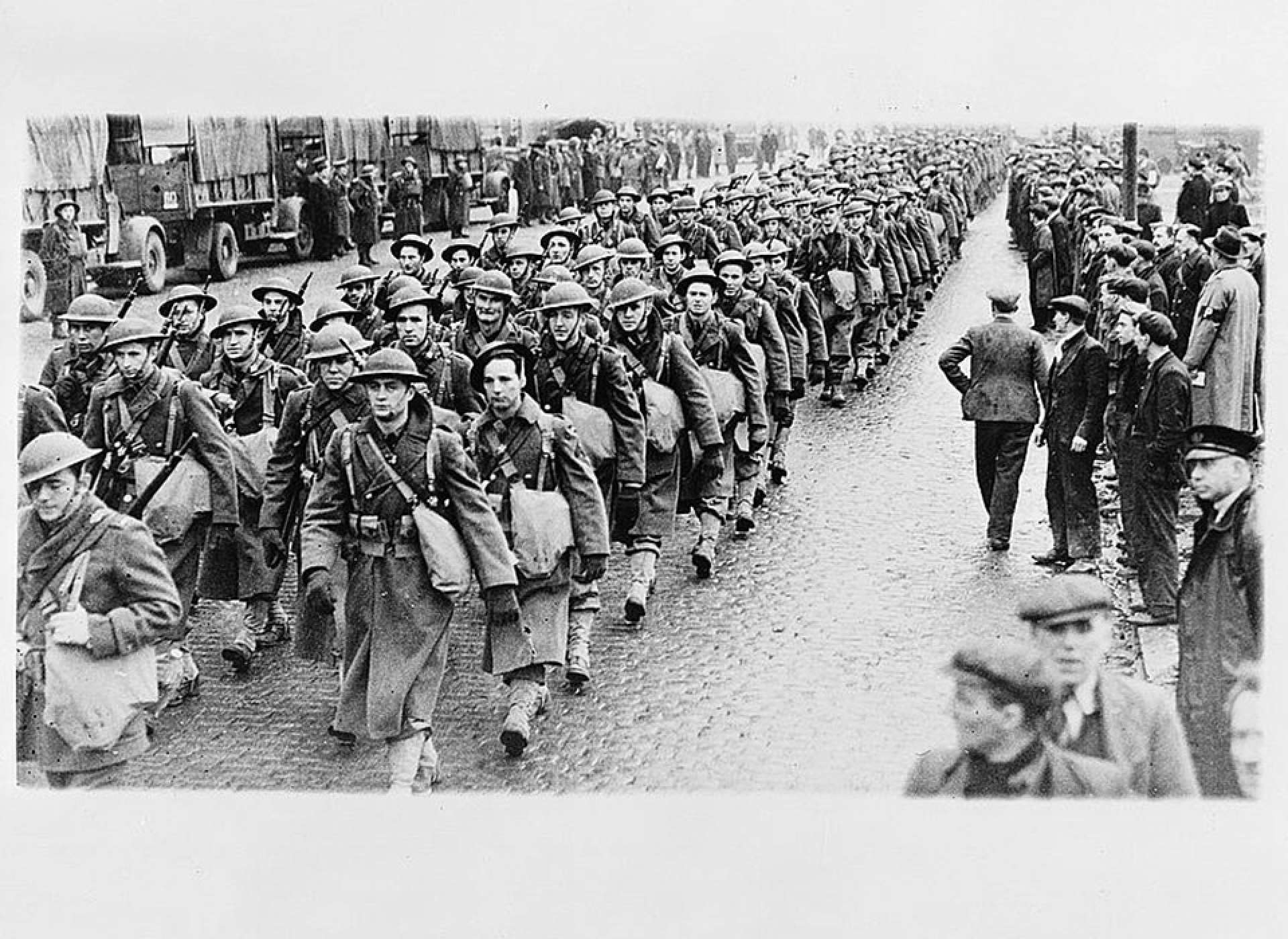
Belfast citizens watch the first contingent of American soldiers of the 34th Infantry Division after their arrival in Northern Ireland on January 26, 1942. Image courtesy of the Library of Congress.
Churchill and Roosevelt also directed their military leaders to develop a plan for the invasion of French North Africa as part of closing the ring. Indeed, as early as December 23, Churchill proposed that US forces land in French Morocco, assuming a French Government invitation. Roosevelt favored North African operations, and he remained anxious to get American troops into active operations in 1942.
The planners quickly recognized that there was insufficient shipping for all of those movements, as well as for reinforcement of the Pacific in the face of continued disasters there. Plans for the invasion of North Africa were deferred, but the topic would re-emerge in a few months.
Throughout the ARCADIA Conference, however, the situation in the Pacific and Far East with respect to Japan steadily deteriorated. By late December, the Japanese had seized Guam, Wake Island, Hong Kong, and Thailand. They had launched invasions of the Philippines, Burma, and the Dutch East Indies. Malaya was being overrun. MacArthur had declared Manila an open city and withdrawn his forces to the Bataan peninsula. It seemed that Australia and New Zealand required reinforcements and would remain vulnerable until Japanese offensives could be halted.
Under intense Japanese attacks in the Philippines, MacArthur disagreed with the focus in Washington on Germany First. On January 1, the same day the Declaration of the United Nations was signed, MacArthur sent a long message to Marshall calling for a major reorientation in the initial Allied strategy. The British Isles, MacArthur opined, were safe due to the winter weather, and he predicted that Singapore and the Netherlands East Indies would fall if the Philippines fell.
MacArthur argued that for international prestige, as well as military reasons, securing the safety of the Philippines should be the highest immediate priority. As he put it, the United States had a choice either to hold the Philippines “or withdraw in shame from the Orient.”
Rejecting MacArthur’s proposition, at ARCADIA the staffs agreed that in the Far East the objective was to hold roughly along the Malay Barrier which included Singapore and the Dutch East Indies. On January 10, Churchill captured the view of Japan held at the conference, observing, “It is generally agreed that the defeat of Germany, entailing a collapse, will leave Japan exposed to overwhelming force, whereas the defeat of Japan would not by any means bring the World War to an end.” He added that while
”it is right to assign primacy to the war against Germany, it would be wrong to speak of ‘standing on the defensive’ against Japan; on the contrary, the only way in which we can live through the intervening period in the Far East before Germany is defeated is by regaining the initiative albeit on a minor scale.”
In order to regain the initiative, the Allies envisioned holding the Philippines as long as possible in order to detail Japanese forces, retaining supply lines to China, defending Singapore “to the utmost limit,” maintaining air and sea routes to Australia (particularly for the United States), and developing the capability for an offensive counter-stroke. Nevertheless, Japanese forces breached the Malay Barrier in early 1942. Although the Allies agreed upon the importance of seizing the initiative in the Pacific and Far East, how that would be achieved and with what forces and resources remained an open question.
Achievements of the Conference
ARCADIA set the strategic direction for the Anglo-American war effort and instituted coordinating mechanisms for effective wartime supreme command to include the JCS. Certainly, differences remained within that strategic approach and between the Allies. While the strategic framework agreed upon at the ARCADIA Conference provided priorities and objectives, it did not resolve the fundamental service and national differences over how those were to be achieved.
This, however, should not obscure the achievements of the ARCADIA Conference, in particular the strategic framework developed for the defeat of Nazi Germany that served as a guide for the remainder of the war and the efforts to achieve Allied unity of effort in the field and at the national level. Assessing the results of the ARCADIA Conference, Eisenhower noted there were “numerous and important other subjects of discussion but from my place on the fringe of the conference it seemed to me that these were the two greatest accomplishments.”
Michael S. Bell, PhD
Mike Bell is the Executive Director of the Institute for the Study of War and Democracy.
Cite this article:
MLA Citation:
APA Citation:
Chicago Style Citation:
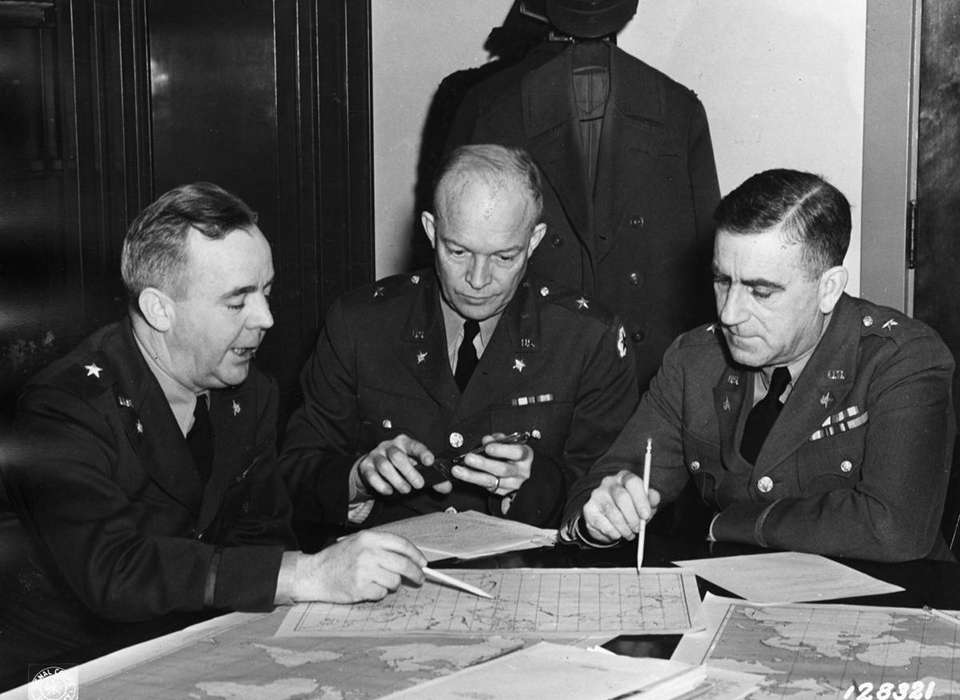

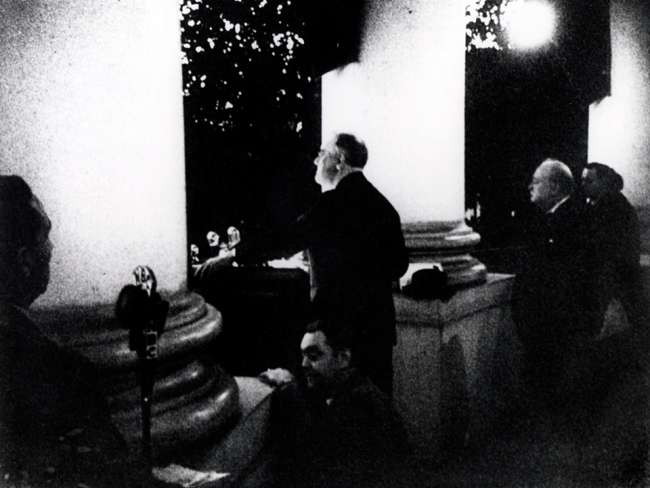
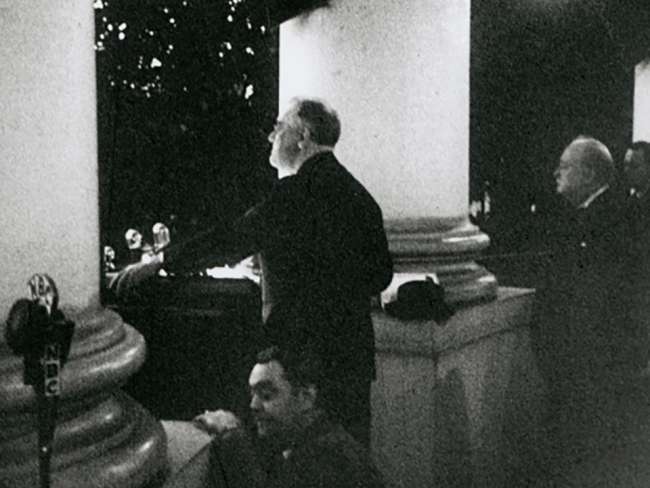




![Max Fuchs, New York City cantor, sings as Rabbi Sydney [sic] Lefkowitz, Richmond, VA, conducts the first Jewish services from Germany.](/sites/default/files/styles/max_650x650/public/2025-10/image1.jpg)


